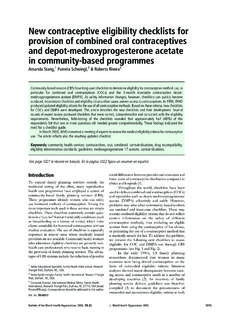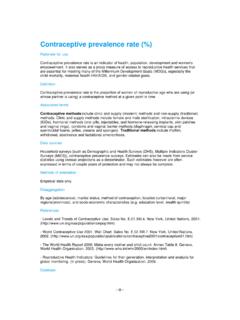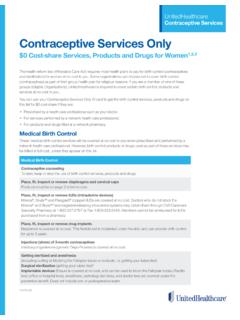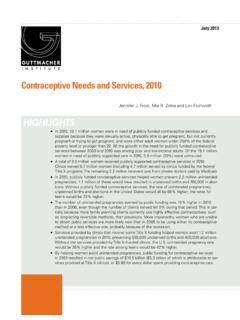Transcription of % of Women Continuing Use at One Year Method …
1 1% of Women Experiencingan Accidental Pregnancy withinthe First Year of Use% of WomenContinuingUse at One Year3 Method (1)Typical Use1 (2)Perfect Use2 (3)(4)Chance48585 Spermicides526640 Periodic AbstinenceCalendarOvulation Method Sympto-thermal6 Post-ovulation25932163 Cap7 Parous womenNulliparous women40202694256 ParaGard T 380 AINTRAUTERINE COPPER CONTRACEPTIVERx onlyPRESCRIBING INFORMATIONParaGard T 380A Intrauterine Copper ContraceptivePatients should be counseled that this product does not protect against HIV infection (AIDS) and other sexually transmitted T 380A Intrauterine Copper Contraceptive should be placed and removed only by healthcare professionals who are experienced with these T 380A Intrauterine Copper Contraceptive (ParaGard ) is a T-shaped intrauterine device (IUD), measuring 32 mm horizontally and 36 mm vertically, with a 3 mm diameter bulb at the tip of the vertical stem.
2 A monofilament polyethylene thread is tied through the tip, resulting in two white threads, each at least cm in length, to aid in detection and removal of the device. The T-frame is made of polyethylene with barium sulfate to aid in detecting the device under x-ray. ParaGard also contains copper: approximately 176 mg of wire coiled along the vertical stem and a mg collar on each side of the horizontal arm. The total exposed copper surface area is 380 23 mm . One ParaGard weighs less than one (1) gram. No component of ParaGard or its packaging contains is packaged together with an insertion tube and solid white rod in a Tyvek polyethylene pouch that is then sterilized. A moveable flange on the insertion tube aids in gauging the depth of insertion through the cervical canal and into the uterine PHARMACOLOGYThe contraceptive effectiveness of ParaGard is enhanced by copper continuously released into the uterine cavity.
3 Mechanism(s) by which copper enhances contraceptive efficacy include interference with sperm transport and fertilization of an egg, and possibly prevention of AND USAGEParaGard is indicated for intrauterine contraception for up to 10 years. The pregnancy rate in clinical studies has been less than 1 pregnancy per 100 Women each 1: Percentage of Women experiencing an unintended pregnancy during the first year of typical use and first year of perfect use of contraception and the percentage Continuing use at the end of the first year: United States1. Among typical couples who initiate use of a Method (not necessarily for the first time), the percentage who experience an accidental pregnancy during the first year if they do not stop use for any other Among couples who initiate use of a Method (not necessarily for the first time) and who use it perfectly (both consistently and correctly), the percentage who experience an accidental pregnancy during the first year if they do not stop use for any Among couples attempting to avoid pregnancy, the percentage who continue to use a Method for one The percents becoming pregnant in columns (2) and (3)
4 Are based on data from populations where contraception is not used and from Women who cease using contraception in order to become pregnant. Among such populations, about 89% become pregnant within one year. This estimate was lowered slightly (to 85%) to represent the percentage who would become pregnant within one year among Women now relying on reversible methods of contraception if they abandoned contraception Foams, creams, gels, vaginal suppositories, and vaginal Cervical mucus (ovulation) Method supplemented by calendar in the pre-ovulatory and basal body temperature in the post-ovulatory With spermicidal cream or Without The treatment schedule is one dose within 72 hours after unprotected intercourse, and a second dose 12 hours after the first dose.
5 Preven is the only dedicated product specifically marketed for emergency contraception. The Food and Drug Administration has also declared the following brands of oral contraceptive to be safe and effective for emergency contraception: Ovral (1 dose is 2 white pills), Alesse (1 dose is 5 pink pills), Nordette or Levlen (1 dose is 4 light-orange pills), Lo/Ovral (1 dose is 4 white pills), Triphasil or Tri-Levlen (1 dose is 4 yellow pills).10. However, to maintain effective protection against pregnancy, another Method of contraception must be used as soon as menstruation resumes, the frequency or duration of breastfeeds is reduced, bottle feeds are introduced or the baby reaches 6 months of should not be placed when one or more of the following conditions exist:1.
6 Pregnancy or suspicion of pregnancy2. Abnormalities of the uterus resulting in distortion of the uterine cavity3. Acute pelvic inflammatory disease, or current behavior suggesting a high risk for pelvic inflammatory disease4. Postpartum endometritis or postabortal endometritis in the past 3 months5. Known or suspected uterine or cervical malignancy6. Genital bleeding of unknown etiology7. Mucopurulent cervicitis8. Wilson s disease9. Allergy to any component of ParaGard 10. A previously placed IUD that has not been removed% of Women Experiencingan Accidental Pregnancy withinthe First Year of Use% of WomenContinuingUse at One Year3 Method (1)Typical Use1 (2)Perfect Use2 (3)(4)SpongeParous womenNulliparous women40202094256 Diaphragm720656 Withdrawal194 Condom8 Female (Reality)Male2114535661 PillProgestin TCopper T 380 ALNg Contraceptive Pills: Treatment initiated within 72 hours after unprotected intercourse reduces the risk of pregnancy by at least 75%.
7 9 Lactational Amenorrhea Method : LAM is a highly effective temporary Method of to Table 1 Source: Trussell J, Contraceptive efficacy. In Hatcher RA, Trussell J, Stewart F, Cates W, Stewart GK, Kowal D, Guest F, Contraceptive Technology: Seventeenth Revised Edition. New York NY: Irvington Publishers, Intrauterine PregnancyIf intrauterine pregnancy occurs with ParaGard in place and the string is visible, ParaGard should be removed because of the risk of spontaneous abortion, premature delivery, sepsis, septic shock, and, rarely, death. Removal may be followed by pregnancy loss. If the string is not visible, and the woman decides to continue her pregnancy, check if the ParaGard is in her uterus (for example, by ultrasound).
8 If ParaGard is in her uterus, warn her that there is an increased risk of spontaneous abortion and sepsis, septic shock, and rarely, In addition, the risk of premature labor and delivery is Human data about risk of birth defects from copper exposure are limited. However, studies have not detected a pattern of abnormalities, and published reports do not suggest a risk that is higher than the baseline risk for birth Ectopic PregnancyWomen who become pregnant while using ParaGard should be evaluated for ectopic pregnancy. A pregnancy that occurs with ParaGard in place is more likely to be ectopic than a pregnancy in the general population. However, because ParaGard prevents most pregnancies, Women who use ParaGard have a lower risk of an ectopic pregnancy than sexually active Women who do not use any Pelvic InfectionAlthough pelvic inflammatory disease (PID) in Women using IUDs is uncommon, IUDs may be associated with an increased relative risk of PID compared to other forms of contraception and to no contraception.
9 The highest incidence of PID occurs within 20 days following insertion. Therefore, the visit following the first post-insertion menstrual period is an opportunity to assess the patient for infection, as well as to check that the IUD is in place. (See INSTRUCTIONS FOR USE, Continuing Care.) Since pelvic infection is most frequently associated with sexually transmitted organisms, IUDs are not recommended for Women at high risk for sexual infection. Prophylactic antibiotics at the time of insertion do not appear to lower the incidence of PID can have serious consequences, such as tubal damage (leading to ectopic pregnancy or infertility), hysterectomy , sepsis, and, rarely, death. It is therefore important to promptly assess and treat any woman who develops signs or symptoms of for treatment of PID are available from the Centers for Disease Control and Prevention (CDC), Atlanta, Georgia at or 1-800-311-3435.
10 Antibiotics are the mainstay of therapy. Most healthcare professionals also remove the significance of actinomyces-like organisms on Papanicolaou smear in an asymptomatic IUD user is unknown,5-6 and so this finding alone does not always require IUD removal and treatment. However, because pelvic actinomycosis is a serious infection, a woman who has symptoms of pelvic infection possibly due to actinomyces should be treated and have her IUD removed. 4. ImmunocompromiseWomen with AIDS should not have IUDs inserted unless they are clinically stable on antiretroviral therapy. Limited data suggest that asymptomatic Women infected with human immunodeficiency virus may use intrauterine devices.








